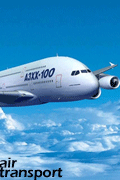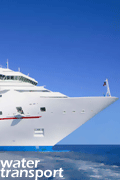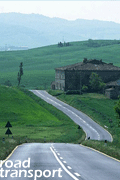Tuesday, September 30, 2008
The Secretary released new data today indicating that Americans drove 3.6 percent less, or 9.6 billion miles fewer, in July 2008 than July 2007. Since last November, Americans have driven 62.6 billion miles less than they did over the same nine-month period last year. Meanwhile, she said, transit ridership is up 11 percent, and in July, Amtrak carried more passengers than in any single month in its history.
"At a time when transit and rail are seeing record growth, the very way we finance these systems is at risk. That is because our transit investments come from the same source as our highway investments – federal gas taxes," Secretary Peters said. "Federal transportation policies that rely almost exclusively on gas taxes are failing our state and local governments."
So as part of a new plan to improve intercity passenger rail service nationwide, the Secretary announced the Department is providing $30 million to match local investments in 15 rail capacity enhancement projects across the country. These federal-state partnerships will support projects designed to reduce delays and expand capacity on existing intercity passenger rail routes and help establish new services where none exist today.
Until now, she said, there has been no way for states to qualify for federal funds to match local investments in rail capacity as all federal funds have gone directly to Amtrak.
But, the Secretary warned, comprehensive reform is needed across the transportation system. In July, the Secretary unveiled a new proposal to reform and target transportation investments where they can best reduce congestion and improve infrastructure, while beginning to move away from relying exclusively on unstable gas taxes to finance transportation investments in the future.
"A few weeks ago, we saw the folly of our antiquated federal transportation policies when the highway trust fund almost ran out of money. If we don't evolve our policies, we will leave a sad legacy of old roads, crowded highways, and unfulfilled transit ambitions," Secretary Peters said.
To view more detail on the VMT data, please visit: http://www.fhwa.dot.gov/ohim/tvtw/08jultvt/index.cfm.
The 15 intercity passenger rail grants the Department is awarding will support planning and construction projects in Arizona, California, Illinois, Maine, Minnesota, Missouri, New York, Ohio, Vermont, Virginia, Washington, and Wisconsin. Projects include:
Arizona: EIS Tucson to Phoenix, $1 million
Description: The planning study would conduct a Phase I EIS for new intercity passenger rail service in the Sun Corridor between Phoenix and Tucson (140 miles). The service would operate trains at speeds up to 125 mph with as many as 15 stations. New track would be needed, existing tracks upgraded, and improved made at many public and private highway-rail grade crossings. The Phase I EIS will complete a majority of the environmental analysis necessary for project development and result in a selection of alternatives for further design and feasibility studies.
Benefits: There is no daily, punctual rail service in this corridor today (the unreliable Amtrak Sunset Limited is tri-weekly). Modern rail service is projected to carry approximately 1.2 million passengers annually. This service could ultimately interlink with commuter rail programs.
California: San Joaquin Corridor - 4.5-mile double tracking, Kings Park, $5 million
Description: The project involves the conversion of 4.5 miles of running side track to a second main line, construction of side tracks, the addition of two #24 crossovers and other turnout improvements, as well as related signal and highway crossing improvements. Completion of the project will result in 9.5 miles of continuous double track that will allow trains to pass each other at maximum track speed of 79 mph. This location has been identified as one of the worst congestion points in the corridor and a priority for capacity enhancement on the BNSF sections of the San Joaquin service route operated by Amtrak.
Benefits: The project would connect existing sections of double track. With the recently completed Shirley to Hanford project to the north, the Kings Park project would result in a continuous 9.5 mile section of double main track. Operations analysis indicates that the project would reduce Amtrak train delays by 5 hours per week and increase average speeds of the San Joaquin service by 1.3%.
Illinois : Installation of Centralized Traffic Control and Cab Signals from Joliet to Mazonia, $1.55 million
Description: Replace the existing Automatic Block System (ABS) with a Centralized Traffic Control (CTC) and Cab Signal system on a 24.7 mile segment on the Chicago to St. Louis high-speed rail corridor from Joliet to Mazonia (Dwight).
Benefits: Project will upgrade train operations from Joliet to Mazonia on the Chicago to Springfield/St. Louis corridor with centralized train control technology and cab signals to improve the safety and reliability of train service between Chicago and Joliet. The upgraded signal system will provide for a 30 minute reduction in delays, currently experienced with operations over the existing signal system. Project will also upgrade circuitry at grade crossings along this route. Ultimately, the installation of CTC and cab signal technology will enable Amtrak to increase train speeds up to 110 mph in sections of this corridor capable of supporting high speed operations.
Illinois : Installation of Cab Signal Technology from Mazonia to Ridgeley (Springfield) $1.85 million
Description: Install Cab Signal system and Advance Activation System on 118.4 route miles between Mazonia (Dwight) and Ridgley (Springfield) on the Chicago to St. Louis high-speed rail corridor.
Benefits: Enables the State and Amtrak to increase train speeds to 80 and 110 mph in sections of this corridor capable of supporting high speed operations, providing for a 24-minute reduction in travel time through this segment. Includes the installation of an Advance Activation System for safer operation of high speed trains through grade crossings and supports cab signal technology already installed on UP freight locomotives.
Maine: Portland Area Track Improvments, $500,000
Description: The Northern New England Passenger Rail Authority (NNEPRA) proposes to undertake a state-of-good-repair track improvement project on rail lines owned by Pan Am Railways in the Portland, ME area. These include tracks extending from the Portland station to the layover facility, including a wye. The only passenger service using these tracks is the State-supported Downeaster service, which currently operates at five freqencies per day. A portion of the track to be improved is not currently used for revenue operations, and the wye is now out of service for turning of passenger train consists.
Benefits: The quantified anticipated benefits relate primarily to the renewed ability to turn locomotives and trainsets on the wye, a procedure which the applicant regards as necessary when locomotives are bad-ordered. The applicant also asserts that the current inability to do this requires that a protect locomotive be held in reserve in Portland, and that the net present value of the cost of the protect locomotive over the 15-year life of the proposed improvements would be $6.5 million. Prior to submitting the application, however, the applicant told the FRA that the long-term intent of the project would be to accommodate an extension of Downeaster service to Brunswick, which would use the improved track for revenue movements.
Minnesota: PEIS Twin Cities to Duluth High-Speed Rail, $1.1 million
Description: The planning study is to to prepare a Programmatic Environmental Impact Statement (PEIS) for new passenger rail service from Minneapolis to Duluth where there is currently none. The PEIS would address proposed rail infrastructure improvements to support high speed rail service up to 110 mph along the BNSF line, for a distance of about 150 miles. A feasibility study was completed for the proposed service that describes a range of rail improvements from conventional 79 mph service to 110 mph service requiring a full train control system. Capital improvements are estimated to range from $75 to $400 million (2006 dollars).
Benefits: Completion of the PEIS would advance the project to be ready for implementation steps. A PEIS would set the stage for discrete capital projects that could be completed over time as the service is introduced and expanded. The proposed project would introduce intercity passenger rail service where there is none today. In 2009 a commuter rail service is planned to start along the Minneapolis end of the route and both services would terminate at the same station and connect with transit.
Missouri: Siding Extension, St. Louis-Kansas City, $3.3 million
Description: Missouri DOT proposes the construction of one 9,000 ft. passing track (near California, MO), and completion of preliminary engineering for a second (in Knob Noster, MO), on Union Pacific's (UP) Sedalia subdivision between Jefferson City and Kansas City, to be used by the State-supported Mules and Anne Rutledge services (two frequencies per day). These new tracks would eliminate two existing 20+ mile gaps between passing tracks on a primarily unidirectional line.
Benefits: The applicant states that completion of these projects would eliminate up to an average of 6 minutes of delay per train due primarily to freight train interference. These estimates are supported by an extensive simulation study performed by the University of Missouri which identified capital investment projects which would improve OTP on the cross-Missouri route.
New York: Albany Station Track and Signal Improvements, $1.25 million
Description: New York State DOT proposes to perform full engineering of a significant multiphased reconfiguration of the interlockings in and around Albany-Rensselaer Station. The station serves the Empire Service, Lake Shore Limited, Ethan Allen Express, and the State-supported (north of Albany) Adirondack. The proposed project includes installing a station track on the currently-unused east face of the east island platform, the addition of pocket tracks, and the reconfiguration of the Post Road connection used by the Boston section of the Lake Shore Limited.
Benefits: The full implementation of the reconfiguration will allow for improved speeds approaching and departing the station resulting from the improvement of signal aspects through the installation of track circuits and the realignment of tracks to allow for non-diverging moves to and from the inboard island platform faces. The project represents the first comprehensive reconfigurations of one of the busier station interlocking in the U.S. since the time it was first cobbled together in the late 1960s.
Ohio:Cleveland-Columbus-Dayton-Cincinnati Planning and Alternatives Analysis, $62,500
Description: Ohio has contracted with Amtrak to assess the feasibility of initiating a start-up service of two round trips per day between Cleveland and Columbus and possibly to Cincinnati (which together define the "3C corridor"). The planning project would complement the Amtrak assessment and advance the analysis of alternative 3C routes and station locations that will most effectively serve the corridor - both in the short-term and the long-term. The tasks include: program management, coordination with Amtrak and oversight of Amtrak train operations analysis; drafting purpose and need; and long term alternative route analysis.
Benefits: The planning objectives are to support the state initiative for start-up service in the short term by conducting short-term/long-term planning analysis of 3C corridor requirements. This will help to align any short-term actions with the long-term needs, planning and environmental documentation. It is expected that the project would: 1.) Support a State-supported Amtrak startup service; 2). Advance the conceptual engineering and analysis of alternative routes and station sites and facilities; and 3.) Clarify a long-term corridor development strategy.
Vermont: Vermonter Route – One-Mile Rail Replacement/Bridge Redeckings, $450,000
Description: The Vermont Agency of Transportation proposes a state-of-good-repair project to replace one mile of rail and redeck four bridges on the slow-order-laden New England Central Railroad (NECR) route of the State-supported Vermonter, which operates at one frequency per day each way.
Benefits: The applicant states that the proposed project is anticipated to result in the reduction of 12 minutes of slow-order delay per train.
Vermont: Ethan Allen Route - 2-Mile Track Reconstruction,$581,775
Description: The Vermont Agency of Transportation proposes a state-of-good-repair project to rebuild 2 miles of slow-order-laden track on the Clarendon and Pittsford Railroad near Rutland, VT, on the route of the State-supported Ethan Allen Express, which operates at one frequency per day each way. The project involves the installation of continuous welded rail, 2000 new ties, and renewal of the roadbed.
Benefits: The applicant states that the proposed project is anticipated to result in the reduction of 10 minutes of slow order delay per train. However, the project location's proximity to the Rutland Yard limits and Rutland station calls into question whether speeds could fully attain the levels projected in the application.
Virginia: Third Track south of Fredericksburg, $2 million
Description: Construction of a third track south of Fredericksburg Station in Spotsylvania County. Project includes the rehabilitation of 3.1 miles of existing track (currently used as a siding) to serve as a third track for passing. Components of the project include an upgrade to the subgrade, track structure, and interlockings, as well as the removal an obsolete industrial siding. FRA funding of this project would support an offset project to design the AM interlocking near Richmond Main Street Station, with a potential extension of the design from the Main Street Station through Acca Yard to the Staples Mill Station.
Benefits: Projected improvements include increased reliability, reduced delays and improved OTP (by 4%) to 80%. Project will provide the only location where a passenger train can over-take another train without opposition between Richmond and Alexandria.
Washington: Point Defiance Bypass (D-M Street Tacoma), $6 million
Description: This project will provide for preliminary engineering, environmental review, and right of way acquisition for the 1.2 mile D to M street segment of the 19.5 mile Point Defiance Bypass project from Tacoma to Nisqually. The D to M street segment will include new track and signal systems on a realigned right-of-way in Tacoma, including a grade-separated railroad crossing at Pacific Avenue. Ultimately, the Point Defiance Bypass Project will redirect intercity passenger trains between Tacoma and Nisqually from the circuitous BNSF freight line along the coast to a passenger oriented inland route.
Benefits: The new routing will enable WSDOT to operate two additional round trip Cascades trains from Portland to Seattle and SoundTransit's Sounder to extend service to Lakewood. The project will reduce travel time by 6 minutes between Portland and Seattle as well as avoid freight traffic interference through two single-track tunnels and port activities along the current route. Ultimately, Amtrak services will relocate to the newly constructed Freighthouse Square station in Tacoma providing direct access to SoundTransit's Sounder commuter rail, and Link light rail to downtown Tacoma.
Wisconsin: Chicago-Milwaukee Welded Rail (17.85 mi), $5 million
Description: The project will install 17.85 miles of continuously-welded rail (CWR) in the Canadian Pacific right-of-way between Milwaukee and the IL/WI state line, replacing the last sections of remaining jointed rail on the Milwaukee-Chicago corridor. Project will include replacement of ties and other related track materials, where necessary, as well as the reprogramming of grade crossings for higher speeds.
Benefits: CWR will increase the reliability of passenger trains on the Milwaukee-Chicago corridor by increasing speeds (from 70 to79 mph on downgraded jointed track), reducing travel time (by 1.7 minutes), and eliminating delays and slow orders associated with ongoing maintenance of jointed rail (by up to 70% or 4 minutes per 1000 train miles for jointed track). These improvements will insure a greater on-time arrival into Metra territory, avoiding a potential 10-20 minute delay into Chicago. In addition, CWR will provide enhanced ride quality for Amtrak passengers and equipment.
Wisconsin: Midwest Regional Rail Initiative* (MWRRI) Alternatives Analysis and Planning (Phase 7) $297,000
Description: Continued planning for the Midwest Regional Rail Initiative (MWRRI) including alternatives analysis, updating MWRRI system costs, equipment, train control and operational plans, and the preparation of public outreach materials. The project covers some program management, updating South of the Lake alternatives analysis between Chicago, IL and Porter, IN, and preliminary alternatives analysis in other corridors.
Benefits: This planning work is intended continue the MWRRI on a path toward implementation by updating and refining key MWRRI plan elements and public information materials and completing corridor alternatives analysis work called for in the FRA Rail Corridor Transportation Plan Guidance Manual and required to meet the requirements of the federal NEPA process for the preparation of a programmatic Environmental Impact Statement for route selection in MWRRI corridors. *MWRRI is a coalition of states and Wisconsin serves as the administer of program funds.
posted by transport blogs
@ 9:25 PM
permanent link | Post a Comment
|
0
comments
![]()
Monday, September 29, 2008
Rider Safe, the State Government's compulsory pre-licence motorcycle training course, teaches basic and advanced motorcycle skills, and offers refresher training for experienced motor cyclists.
Features of the new facility include a larger training range with a smoother surface and larger run off areas, making for safer, more efficient riding.
There has been a steady demand for Rider Safe training in Whyalla and anticipates that the new and improved facility will cater for present and future needs.
Rider Safe aims to improve safety for motor cyclists and ensure that they understand the importance of safe road use.
The project has supported employment opportunities in Whyalla by using local Rider Safe Instructors to conduct courses and local sub-contractors during construction.
Rider Safe courses are conducted on weekends and bookings can be made by contacting telephone 1800 018 300.
The new upgrade is part of the $635 000 Rider Safe upgrade, funded by the State Government.
posted by transport blogs
@ 2:16 AM
permanent link | Post a Comment
|
0
comments
![]()








